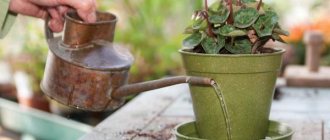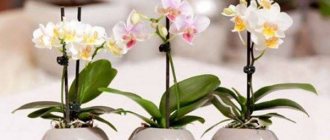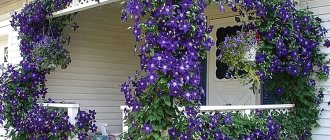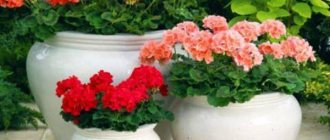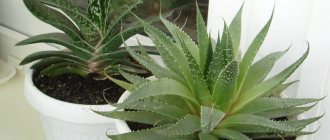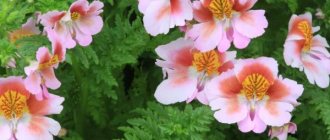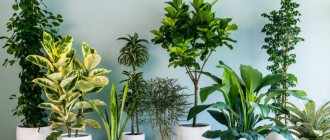Artificial watering for house plants is a key factor for proper development. Not a single living plant can do without life-giving moisture, but in harsh urban conditions, ordinary water can contain too many harmful impurities, which raises the question, is it possible to water indoor flowers with boiled water? After all, such moisture becomes softer and during the boiling process loses all pathogenic microflora. This article will help you understand the topic.
Is it allowed?
Watering flowers with boiled water is possible and even necessary.
Many plants have a very negative attitude towards hard H2O, which is drawn from the tap . If you water them regularly, this will lead to gradual salinization of the soil cover.
The roots have a thin membrane that absorbs nutrients after watering. Calcium does not dissolve well in hard water, so if you water plants with it, the pores of the membrane will begin to clog, disrupting water exchange. Their condition will worsen, the flowers may even die.
To protect plants, it is recommended to soften H2O . One method is boiling. After boiling, magnesium and calcium salts settle at the bottom of the pan.
In addition, disinfection occurs - many polluting substances harmful to plants disappear.
Weighing the pros and cons
Raw, unboiled water is most beneficial for plants, because it contains a lot of oxygen, which is vital for flowers, as well as useful minerals, vitamins and other complexes. Natural rain moisture or melted snow is considered especially valuable.
However, such a liquid can be considered useful only conditionally, and only if it is collected in places remote from polluted city streets. Car exhaust fumes, harmful fumes from factories and factories, and other toxic substances poison the atmosphere, and precipitation can be dangerous even for strong garden crops, let alone delicate indoor pets.
Tap water directly from the tap is also unsuitable for irrigation and requires special preparation. Most often, it is simply left to stand for several days in an open container, while more toxic volatile components evaporate, and heavy hardness salts settle to the bottom, but the issue of dangerous microorganisms still remains open. Therefore, caring owners often resort to the boiling method, but are tormented by questions about whether it is possible to water plants with boiled water and how useful such watering is for home crops.
The advantages of boiling include:
- neutralization of impurities of manganese and iron salts into simpler elements;
- precipitation of calcium and magnesium salts in the form of plaque on the walls of the vessel;
- reducing the hardness of tap water;
- destruction of dangerous bacteria and viruses as sources of diseases for indoor plants.
The benefits of boiling are invaluable, but it is also necessary to note the disadvantages of this procedure:
- loss of most of the free oxygen that the root system of home flowers needs for normal functioning;
- loss of vitamins and minerals needed by plants that cannot withstand high temperatures.
Considering these disadvantages, there are several varieties of indoor plants that do not tolerate boiled water. These include: violets, gardenias, hibiscus, oleander, etc. At the same time, cacti and succulents, on the contrary, prefer boiled soft moisture.
You can determine if a houseplant is not satisfied with its nutrition visually. It is important not to miss negative signs and change the watering schedule or structure in a timely manner.
Advantages and disadvantages
A significant advantage is that, unlike raw water, boiled water contains significantly fewer harmful substances that can worsen the condition of indoor flowers.
Boiled water has a serious drawback - it contains minimal oxygen and nutrients.
But this minus is compensated for in several ways:
- The shortage of necessary elements can be eliminated by applying fertilizers.
- Leave the water to stand for 24 hours, after which it will become more enriched with oxygen.
- Periodically loosen the soil, which will improve root oxygen saturation.
Rules for watering with tea leaves
Welding is the best solution in situations where it is not possible to buy mineral products to enrich the soil. Water flowers only with tea leaves that are weakly brewed, not strong.
Do not use tea leaves with added sugar under any circumstances and remember that the frequency of watering with it should be approximately once or twice every two weeks.
Tea leaves benefit such types of indoor flowers as geraniums and violets; they grow quickly and they constantly need useful nutrition.
Which is correct?
The main rule is not to water flowers that stand on a window or windowsill, and sunlight falls on them. This may cause the leaves to burn.
Some tips on how to safely moisten the soil:
- Before watering the plants, check the condition of the soil. It should dry well. If it collects in clumps, it means there is still enough moisture and watering is not required yet. Excess moisture will damage the flowers.
- When watering, fill with water to the top edge of the pot. All excess will seep through the soil layer and accumulate in the pan.
- You need to pay attention not only to watering the soil, but also to spraying the leaves.
In order not to harm the plants, you need to monitor the temperature of the water for irrigation. It shouldn't be cold or hot. The optimal level is room temperature.
It is recommended to pour it into a watering can in advance and let it brew for a day. During this time, all unnecessary substances contained in the water will settle, and it will acquire the desired temperature.
To prevent the appearance of whitish marks on the leaves after watering, which are typical when watering with boiled water, you should add a little lemon juice or grains of citric acid to the liquid .
You need to spray the flowers and water the soil. The frequency and intensity of watering is individual for each indoor plant.
Useful tips
When deciding whether it is possible to water flowers with boiled water, it is important to remember that such moisture will not cause harm, and if you follow some recommendations, it can even become a salvation, because boiling removes sources of hardness and infections. So, to get the maximum benefit from watering with boiled water, you need to:
- It is important to remember that the temperature of boiled water should be as close as possible to the air temperature in the room. Do not apply too cold or too hot moisture. The range ranges from 18...25 °C.
- Keep the boiled moisture for at least 24 hours in an open container to saturate the air with oxygen.
- Combine watering with fertilizing with liquid fertilizer solutions. The potassium-phosphorus complex and nitrogen are especially important (it all depends on the period and life phase of the plant). In this case, fertilizers can be dissolved directly in boiled water.
- After the procedure, it is important to thoroughly, but carefully, loosen the soil in the pot, providing additional oxygen access to the root system.
The process of boiling hard water softens it, removes most harmful salts and destroys harmful microorganisms. It is possible to water plants with boiled water, and many owners practice this method for their home greenhouses, while following some useful recommendations.
How to determine that such watering is not suitable?
Signs by which you can determine that such watering is not suitable for a particular plant:
- the tops of the shoots die off;
- buds fall;
- root rot develops;
- the plant withers.
If water for irrigation is not suitable for flowers, even fertilizers are unlikely to neutralize their deteriorating condition.
Why should the water be warm?
If you use water with a temperature below 15 degrees for irrigation, this can lead to the following negative consequences:
- Slowing down all biological processes of plants.
- Many substances do not dissolve well in cold liquid. For this reason, watering will prevent the plants from receiving the necessary benefits.
- When watering with cold liquid, young shoots of the root system are severely damaged.
- Cold watering reduces the immunity of plants, making it more difficult for them to resist diseases and pests. The ability to recover is also impaired.
To avoid unpleasant consequences and ensure normal growth and development of plants, water them only with warm water. A temperature of 25-30 degrees or slightly higher is considered acceptable.
Is it possible to water indoor flowers with water from an aquarium?
An aquarium is a closed ecosystem. Microorganisms and bacteria live in it. Dissolved minerals, vitamins, humic acids. The liquid is warm and oxygenated. Inhabitants are fish and snails, which add urea.
Water from an aquarium is no longer just life-giving moisture, but an organic substrate.
Regarding its use, the opinions of flower growers are completely opposite. Some consider aquarium substrate an elixir for moisture-loving species. They notice the lush flowering and lush greenery of the potted inhabitants. Others are not seeing fantastic growth.
Even specialists are not enthusiastic about the method. The undoubted benefits are considered:
- temperature of the irrigation liquid;
- savings on fertilizing;
- oxygen saturation;
- no chlorine.
But it cannot be called clean, even despite the filters. There will be no harm to plants from aquarium liquid if you moisten the soil periodically - once a month.
Disadvantages of watering with tea leaves
Steamed tea contains active, often living, organisms. That is why, in the cold season, the flower soil, watered with tea leaves, begins to mold, and small midges begin to fly over it.
Remember also that modern brands of tea contain a large number of dyes, unnatural components, and they are a harmful additive to the earth.
By and large, the method of watering with tea leaves is considered obsolete; it was used when it was not possible to purchase selective mixtures for watering plants and enriching soils.
Watering rules: from sowing to seedlings
In order not to bury the seeds when sowing, first fill the container with soil 1 cm below the required level, then water well - and only after that sow, sprinkle them with soil on top. A small watering can with a long spout is suitable for watering.
Until seedlings emerge, containers with crops are kept under film. Moisture accumulates underneath it, which prevents the soil from drying out. The soil is moistened with a spray bottle.
During the cotyledon formation phase, seedlings are especially susceptible to blackleg, a disease that can destroy the plant. The infection is dangerous from the moment the seeds germinate until 2–3 true leaves appear. To prevent the development of the disease, disinfect the soil before sowing, treat the seeds, and avoid waterlogging the soil. Better to underwater!
When watered, very small seedlings bend to the ground under the weight of the drops. To prevent the sprouts from falling to the ground, water at first using a syringe, pipette, or syringe. It is also not recommended to irrigate young seedlings from above - at first it is better to evenly direct the water under the root.
watering young still immature lobelia shoots from a pipette
When the first true leaves appear, it is better to water the plants in the morning - so that by evening the leaves and soil have time to dry out. In the afternoon, the temperature drops, which, together with moisture, creates ideal conditions for the development of pathogenic fungi. It is better to water the planted seedlings of pumpkin, root vegetables and herbs by sprinkling, using a regular watering can with a divider, a hose with a nozzle (with a small diameter of holes) or special sprinklers. This method allows you not only to saturate the plants with moisture, but also to wash away dust from the leaves - and also to humidify the air in general. It is best to water in the morning or evening, in calm weather.
When watering at the root, on the contrary, the leaves remain intact, which is ideal for nightshades - tomatoes, peppers, eggplants, potatoes, and in general for crops that are contraindicated in high air humidity. When using a sprinkler system, these plants may develop late blight - one of the most common plant diseases, in which the crop becomes covered with unpleasant brownish spots and plaque, and the affected areas die off, as a result of which the plant itself dies. You can water at the root using a regular watering can or hose.
In a greenhouse, along with subsoil irrigation, the most effective method is drip irrigation, in which water is supplied through a pipeline or hose system and sprayed through droppers. In both cases, it is spent more economically, watering can be combined without problems with fertilizing the plants, and the soil moisture is stably maintained, which avoids the formation of a soil crust.
But along with the advantages, these two systems also have noticeable disadvantages: for example, they require special equipment that can become clogged - therefore, select water for irrigation especially carefully, passing it through mesh and gravel filters (the latter is considered especially effective if water from open water). Very often they are installed immediately together with a drip irrigation system.
In addition, there is the so-called reverse watering. The area around the plant is covered with a film and also sprinkled with a small layer of earth - about 3 cm. During the day, when the soil heats up, moisture from the ground rises to the upper layers, but due to the shelter it cannot evaporate - and at night it settles on the film and returns to the ground. It is better to water such areas in the morning so that by the end of the day the top layer of soil is already dry - otherwise condensation appears on the film, which flows onto the plants and can cause diseases in them.
watering an already mature cucumber bush
Water requirements
So, we list the basic requirements for water used in watering indoor flowers:
• softness (the concentration of magnesium and calcium ions is assessed); • weak acidity; • with sufficient oxygen content; • with a sufficient amount and full range of necessary macro- and microelements.
One of the recommendations is that it is better to water your indoor plants with slightly salted water. It is known that the concentration of salts decreases noticeably when boiling.
Containing fertilizers
Wood ash. Dilute 3 g of this ingredient in 1 liter of liquid, leave for 7 days, stirring occasionally. Then you can water the flowers. For a 1 liter pot, 10 mg of solution is enough. The main advantage of ash is that all its trace elements can be easily dissolved and absorbed by plants. It is also used as fertilizer during transplantation and propagation - weakened flowers are fed. After the procedure, the leaves become stronger and more buds are formed.
Fresh peat. The substance is mixed at the rate of 100 g per 10 l. Suitable for any plants, it will also fertilize them and reduce the acidity of the soil, which will cause lush flowering.
Tea or coffee are great. For some flowers, watering with tea is even necessary. Substances from tea residues perfectly acidify and nourish the soil, so it can be used when replanting so that the plant receives additional nutrition.
We water the plants during the holidays.
We can all go on vacation, a business trip and be absent for some time. It's good if you have someone to water your plants. If you leave, you have to ask friends or neighbors, relatives and friends, to look after your plants. But you can come up with automatic watering. Or think in advance about planting plants in pots that are equipped with automatic watering. In such pots, plants can go without watering for almost a month. Self-watering pots are an expensive proposition.
Let's look at more budget-friendly methods:
- — the most common way to auto-water plants is to use a cord. You need to place a container of water above the level of the pots with plants. We place the laces in this container (as many as you need to water the pots) and the other end of each lace from the container with water into the pot with the plant. It is better to use wool or cotton lace. The water will gradually be absorbed by the string and transferred to the plant pot.
- - if your pots are clay, dig them into a container with peat (right along with the pots). The peat container should be large enough to accommodate all of your pots. The peat must be moistened very well and the plants themselves must be watered abundantly. Instead of peat, I recommend using expanded clay. It can always be dried and removed, but peat may smell damp in the room. The disadvantage of this method is that it is possible to damage ceramic pots, especially if they are designer or decorative.
- - you can place all the plants together next to each other. In this case, the evaporation of moisture will be less. The more crowded they are on the pallet, the slower the moisture will evaporate. It is advisable to remove the tray with plants from the window. It's better to have a lack of light. With plenty of light, water consumption is greater.
- - There is also a method of watering, for this you will need all kinds of containers. We pour water into them and place a pot with a plant on top. You need to insert a cord into the drainage hole, and lower its other end into the water of the second container. Thus, each pot with a plant will be provided with its own watering. Plants in large pots can be safely left for three weeks without watering, but water them well before leaving.
- — the use of film can reduce moisture evaporation. It is covered on top of the pot. But I would not recommend doing this, there will be a greenhouse effect and the plant trunk may begin to rot. This leads to waterlogging of the soil and rotting of the root system.
- - place the plant in a confined space - for example, an aquarium. But this method is not available to everyone. The bottom is covered with expanded clay, peat or sphagnum, pour water and place the plants. The peculiarity of this method is not entirely convenient, since the pots must stand on their own pallets and there should be no water in them. The plants are well watered and the aquarium itself is covered with glass or film. In this mode, the plants can stand for a month. In such a closed system, water evaporates less and the moisture lasts for a long time.
Water is the source of life for plants. Each plant has its own watering regime and its own watering requirements. Learn how to water your plants and they will thank you. And you will understand how often to water indoor plants. Good luck to you.
How to properly water seedlings at different stages
Any plant at different stages of life requires different amounts of irrigation water.
First stage
Before the emergence of seedlings, it is enough to water the soil once a day, making sure that it is sufficiently dry.
| Important. The main thing is to ensure that a soil crust does not form on the surface of the soil in which the seeds are sown. It’s better to gently loosen the soil with a toothpick once again than to moisten it. The soil also needs to be watered before sowing the seeds, and then cover the containers with film or a piece of glass. |
Second phase
This stage is after the seeds germinate and seedlings appear on the soil surface.
- Remove the film or glass covering the container.
- Stop watering for a couple of days. This will give the root system of the seedlings the opportunity to gain a strong foothold in the soil, show activity, and develop.
- It is necessary to lightly hill up the seedlings.
- Water once every 6–7 days, first checking the soil for moisture.
Photo: Shoots require delicacy.
Third stage
The third stage is when a couple or three true leaves appear. Now the evaporating surface has increased, the plant is actively growing. It requires more water, so you need to moisten the substrate as well as possible.
| Recommendation. You can usually check whether the soil is wet to a sufficient depth with a wooden stick. You need to carefully place it in the ground to the base, and then check the moisture with your fingers. It is necessary to build on the characteristics of the crop - whether it needs a lot of moisture or whether it is not necessary. |

